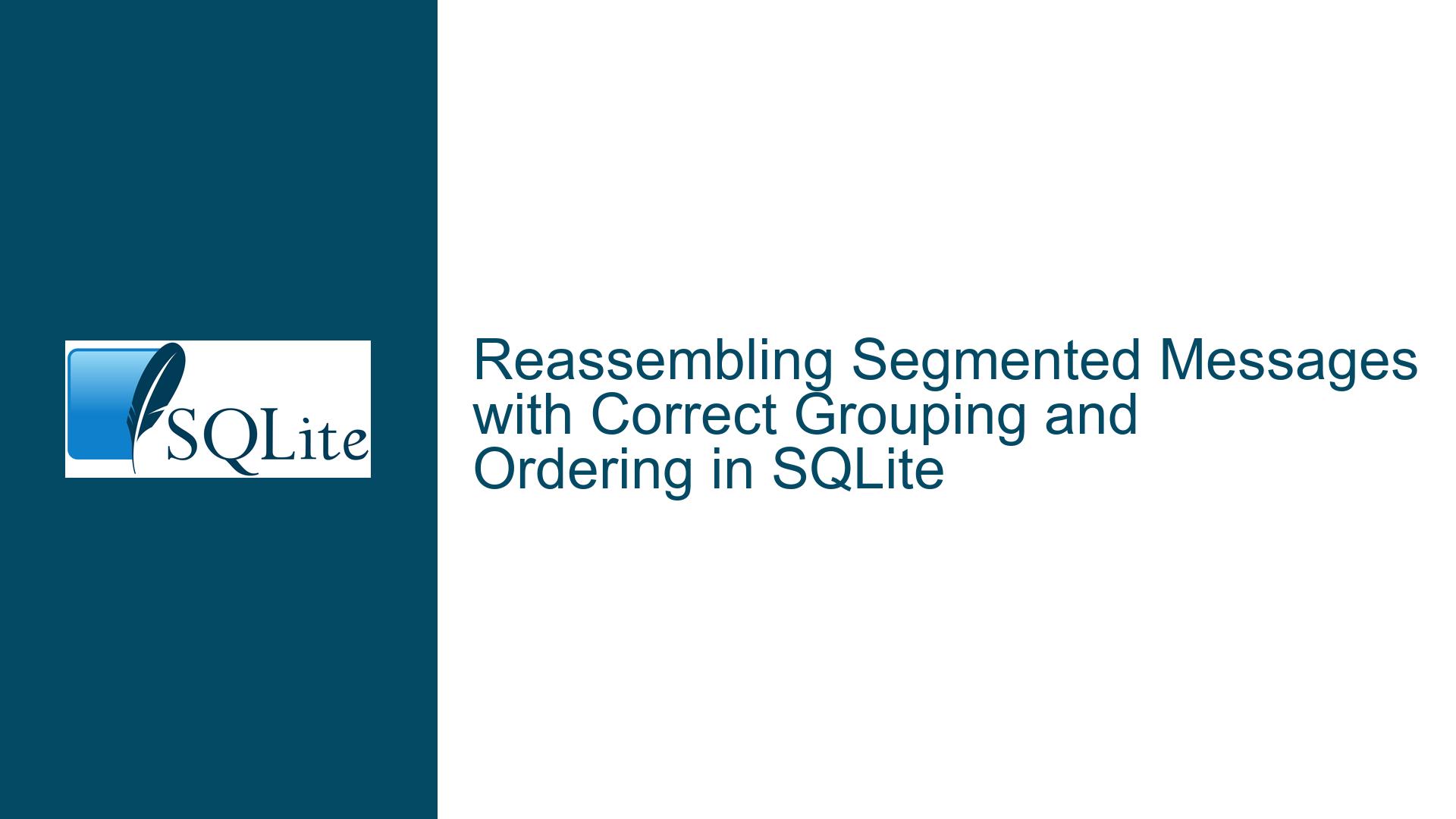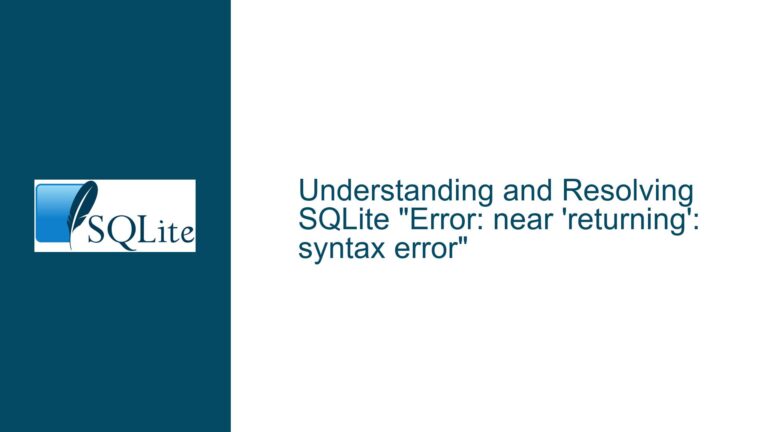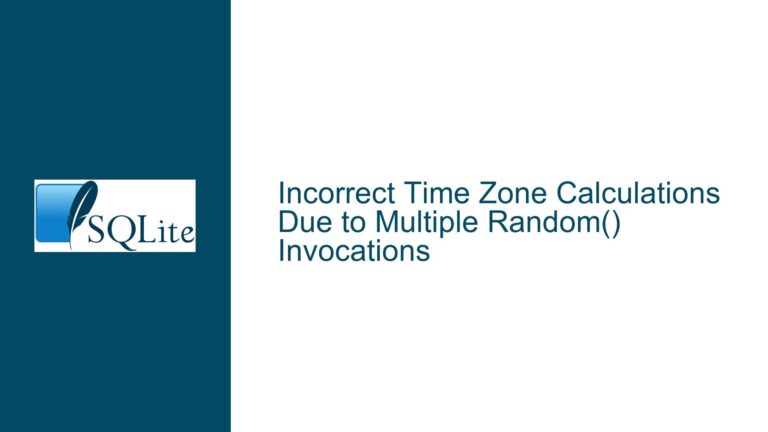Reassembling Segmented Messages with Correct Grouping and Ordering in SQLite
Issue Overview: Combining Segmented Messages with Interleaved Classes and Indices
The core challenge revolves around reconstructing complete messages from segmented parts stored in a SQLite table, where segments may belong to different message classes and have interleaved insertion orders. The table structure includes both complete messages (stored as single rows) and message segments (split across multiple rows with indexing metadata). The primary goal is to concatenate segments within the same message class in the correct order while preserving the original insertion order of complete messages.
Key entities involved:
gidx: A globally incrementing row identifier (primary key).segm: The message content (either a complete message or a segment).tsize: Total size of the reassembled message (NULL for complete messages).segmidx: Segment index within a message (0-based; NULL for complete messages).msgclass: Message class/category (added in later examples).
The initial dataset includes interleaved segments from different classes, making it impossible to rely solely on gidx or segmidx for correct grouping. For example, segments for "Class A" might be inserted between segments for "Class B," requiring a method to group segments by class and index while maintaining insertion order.
Possible Causes: Misalignment in Segment Grouping and Ordering Logic
Lack of Message Group Identifier:
Segmented messages lack a dedicated column to group related segments (e.g., amessage_id). This forces reliance on relative ordering ofgidxandsegmidx, which becomes unreliable when segments from different classes interleave.Insufficient Partitioning by Message Class:
Queries that do not partition segments bymsgclassrisk merging segments from unrelated messages. For example, segments from "Class A" and "Class B" could be concatenated together if not properly isolated.Incorrect Ordering of Segments:
UsingGROUP_CONCATwithout explicit ordering bysegmidxorgidxmay concatenate segments out of sequence. While SQLite’sGROUP_CONCATorder is not guaranteed, practical tests show it follows the source row order, which can be manipulated via subqueries.Overlapping Segment Ranges:
Recursive queries or window functions that fail to define precise boundaries for segment groups may include rows from adjacent messages. For example, a segment withsegmidx=0might incorrectly include segments from a previous message ifgidxranges overlap.Assumptions About Insertion Order:
Solutions assuming contiguousgidxvalues for segments of the same message break when segments are interleaved with other messages or classes. This is evident in scenarios where a new message starts before the previous one ends.
Troubleshooting Steps, Solutions & Fixes: Robust Message Reconstruction Techniques
Step 1: Identify Complete Messages and Segments Separately
Use a WHERE clause to split the dataset into complete messages (segmidx IS NULL) and segments (segmidx IS NOT NULL). This simplifies processing by handling complete messages as-is and focusing logic on segment recombination.
WITH
single AS (SELECT * FROM t_segments WHERE segmidx IS NULL),
multi AS (SELECT * FROM t_segments WHERE segmidx IS NOT NULL)
-- Proceed to process multi CTE for segments
Step 2: Assign Group Identifiers Using Window Functions
Leverage SQLite’s window functions to generate group identifiers. The ROW_NUMBER() OVER (PARTITION BY ... ORDER BY ...) pattern assigns a unique identifier to each segment group within the same class and index partition.
WITH multi_enumerated AS (
SELECT
ROW_NUMBER() OVER (
PARTITION BY msgclass, segmidx
ORDER BY gidx
) AS group_id,
*
FROM multi
)
This assigns group_id to segments, ensuring that segments from different classes or indices are not mixed. For example, all segmidx=0 segments in "Class A" receive sequential group_id values based on insertion order.
Step 3: Concatenate Segments by Group and Class
Use GROUP_CONCAT with explicit ordering to concatenate segments within each group. The ORDER BY segmidx ensures segments are combined in index order (0, 1, 2, …).
SELECT
MIN(gidx) AS gidx, -- Use the first segment's gidx for the complete message
msgclass,
GROUP_CONCAT(segm, '' ORDER BY segmidx) AS reconstructed_segm,
COUNT(*) AS segment_count
FROM multi_enumerated
GROUP BY msgclass, group_id
Step 4: Combine Complete and Reconstructed Messages
Merge the results from the segment processing with the complete messages using UNION ALL, then sort by gidx to maintain insertion order.
SELECT gidx, msgclass, segm FROM single
UNION ALL
SELECT gidx, msgclass, reconstructed_segm FROM reconstructed_multi
ORDER BY gidx
Step 5: Validate Segment Group Boundaries (Advanced)
For scenarios with interleaved segments across classes, define explicit boundaries for segment groups using auxiliary CTEs. This involves calculating the next gidx where a new segment group starts, ensuring segments are grouped correctly.
WITH segment_groups AS (
SELECT
gidx,
msgclass,
segm,
segmidx,
COALESCE(
(SELECT MIN(gidx) FROM t_segments AS next
WHERE next.gidx > current.gidx
AND next.msgclass = current.msgclass
AND next.segmidx = 0),
(SELECT MAX(gidx) + 1 FROM t_segments)
) AS next_group_start
FROM t_segments AS current
WHERE segmidx IS NOT NULL
)
SELECT
MIN(gidx) AS gidx,
msgclass,
GROUP_CONCAT(segm, '' ORDER BY segmidx) AS reconstructed_segm
FROM segment_groups
GROUP BY msgclass, next_group_start
This approach dynamically determines the end of a segment group by finding the next gidx where a new group (with segmidx=0) starts, preventing overlap between groups.
Step 6: Handle Edge Cases and Data Validation
- Validate
tsizeConsistency: Ensure the total length of concatenated segments matchestsizedeclared in the first segment (segmidx=0).
WITH reconstructed AS (
-- Reconstruction logic from Step 3
)
SELECT
r.*,
(LENGTH(r.reconstructed_segm) = s.tsize) AS is_valid_length
FROM reconstructed AS r
JOIN t_segments AS s ON r.gidx = s.gidx
WHERE s.segmidx = 0
- Detect Missing Segments: Use aggregate checks to ensure all segments from
segmidx=0tosegmidx=Nare present.
WITH segment_counts AS (
SELECT
msgclass,
group_id,
MAX(segmidx) + 1 AS expected_count,
COUNT(*) AS actual_count
FROM multi_enumerated
GROUP BY msgclass, group_id
)
SELECT * FROM segment_counts
WHERE expected_count != actual_count
Final Solution: Comprehensive Query with Class Partitioning and Validation
Combining all steps, the final query handles interleaved segments, validates data consistency, and maintains insertion order:
WITH
single AS (SELECT gidx, msgclass, segm FROM t_segments WHERE segmidx IS NULL),
multi AS (SELECT * FROM t_segments WHERE segmidx IS NOT NULL),
multi_enumerated AS (
SELECT
ROW_NUMBER() OVER (
PARTITION BY msgclass, segmidx
ORDER BY gidx
) AS group_id,
*
FROM multi
),
reconstructed_multi AS (
SELECT
MIN(gidx) AS gidx,
msgclass,
GROUP_CONCAT(segm, '' ORDER BY segmidx) AS segm,
COUNT(*) AS segment_count
FROM multi_enumerated
GROUP BY msgclass, group_id
)
SELECT gidx, msgclass, segm FROM single
UNION ALL
SELECT gidx, msgclass, segm FROM reconstructed_multi
ORDER BY gidx;
Output:
gidx | msgclass | segm
-----|----------|------------------------------
1 | A | This is a complete message 1
2 | B | This is for class B
3 | A | This is a complete message 2
4 | A | This is a complete message 3
6 | B | This is for class B
8 | A | This is a complete message 4
This approach ensures correct message reconstruction across classes, handles interleaved segments, and validates data integrity where applicable.






